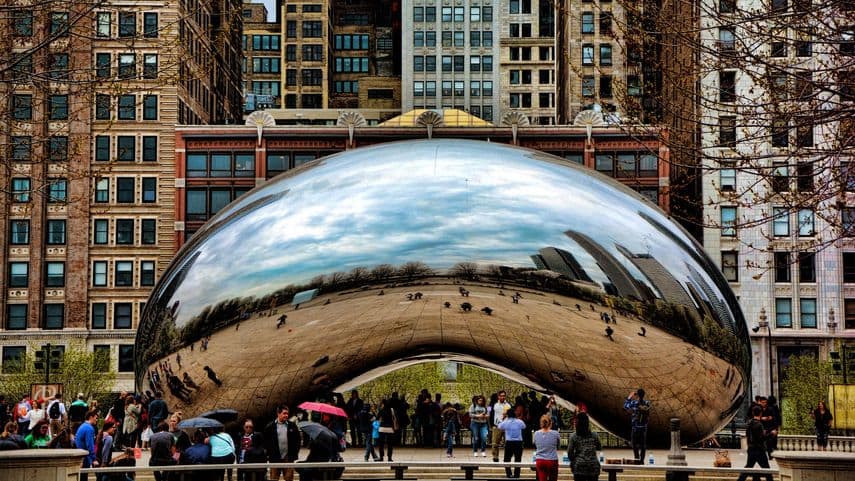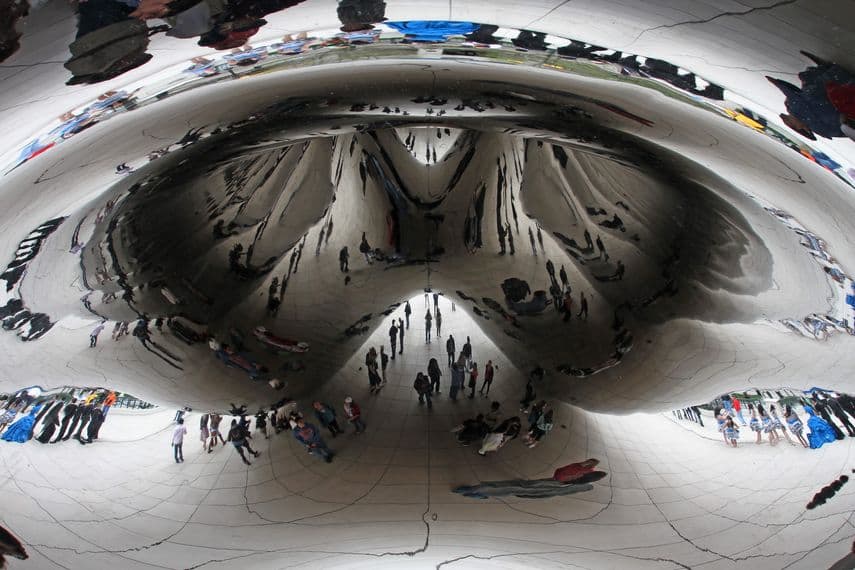[ad_1]
Every day, thousands of people interact with Anish Kapoor’s Cloud Gate in Chicago’s Millennium Park. Affectionately nicknamed The Bean, this immense mirrored sculpture has been described by critics as a passage between realms. Made up of 168 stainless steel plates welded together and placed on the ground, it is about 10 meters tall, with a base of about 20 by 13 meters, weighing 110 short tons.
Constructed between 2004 and 2006, the Chicago Bean reflects upon many of Kapoor’s artistic themes. Inspired by liquid mercury, the sculpture’s surface plays with the light and mixes all the reflections of Chicago and its environment, day and night. Since eighty percent of the sculpture reflects the sky, the artist decided to name the colossal sculpture Cloud Gate, referring to it acting as a type of gate that helps bridge the space between the sky and the viewer. Constructed with a high arch featuring an “omphalos”, a concave chamber that warps and multiplies reflections, it invites public participation and beckons the passer-by to step inside. Anish Kapoor explained:
The work itself has a complete circle of meaning and counterpoint. Without your involvement as a viewer, there is no story.
At once monumental and inviting, Cloud Gate appears to float over the AT&T Plaza with an extraordinary sense of lightness. Ever since it was first unveiled, it became one of Chicago’s most popular attractions.

The Construction of the Sculpture
The Cloud Gate was the result of a design competition which reviewed the artistic works of 30 different artists. Only two were asked to submit proposals, Anish Kapoor and Jeff Koons, who proposed a permanent 150-foot sculpture of a playground slide. After Kapoor’s design was chosen, there were numerous technological concerns regarding its construction, assembly and maintenance, including the experts who claimed that the design could not be implemented. Although the cost for the piece was first estimated at $6 million, the final figure escalated to $23 million in 2006.
Initially, the work was supposed to be installed at the Lurie Garden at the southeast corner of the park, but the officials decided the piece was too large for the area and relocated it at AT&T Plaza, despite Kapoor’s objections. Estimated to weigh approximately 60 short tons, the final figure of the piece turned out to be almost twice as heavy at 110 short tons. Concerned about the sculpture’s weight, the engineers additionally braced its supporting structures and implemented several steel structures inside its shell to keep it standing. The plates of the outer shell were fabricated using three-dimensional modeling software, bent and precisely shaped with the help of computers and robots, and welded together on-site with no additional cutting or filing.
Since the assembly of the Chicago Bean has fallen behind schedule, the piece was temporarily uncovered in an unpolished and thus unfinished state on July 15th, 2004. The seams between the sections of the shiny metal skin were unsealed and unpolished, making them visible. Although Kapoor was unhappy with the revealing of the sculpture in this state, the work was left uncovered for several months, until the tent around it was again erected in January 2005 to allow the workers to grind, sand and polish the seams, producing the sculpture’s mirror-like finish. Due to the premature unveiling, many Chicagoans were highly critical and dismissed the unfinished Cloud Gate as a piece of metal.
The finished piece was officially unveiled on May 15th, 2006, with the public taking an instant liking to it. The New York Times described it as both a “tourist magnet” and an “extraordinary art object”.

The Ideas Behind the Cloud Gate
Known for creating spectacles in urban settings, Anish Kapoor had previously created a range of works of extreme size and scale which reflected and distorted their surroundings. In an interview he gave for The Talks in 2015, he insists on the link between his mirrors and their place of installation, the space they open by deciphering the world around them.
Drawing on these ideas, Cloud Gate acts as an instrument which allows everyone to play with light to propose all the mixtures, all the distortions, all the reconstructions of this landscape. It changes the viewer’s perception of themselves and their surroundings while limiting them to partial comprehension at any time.
Kapoor himself explained the work deals “with serious questions about form, public space and an object in space”.
You can capture the popular imagination and hold other points of interest, but that is not what I set out to do, although there is inevitably a certain spectacular in an object like this
As many of Kapoor’s other works, Cloud Gate removes any trace of their fabrication by hand, presenting itself as the revealed instead of constructed reality. At the same time, this reflective and seamless surface makes the work seem light and close to weightless. Since the viewer is encouraged to walk around and underneath the work into its “navel”, this imbues the sculpture with a spiritual dimension as well. Described as a “warped dimension of fluid space,” the sculpture’s omphalos deconstructs empirical space and ventures into manifold possibilities of abstract space. Framing the view, the sculpture is celebratory in the way it creates a ceremonial place.
At the same time, Cloud Gate relies on the experience of opposites which, as Kapoor once explained, “allows for the expression of wholeness.” It represents both the male and female in one entity by symbolizing both the vagina and testicles, highlighting the tension between the masculine and the feminine.
The Chicago Bean as a Subject of Inside Jokes
Immediately after it was revealed, the public and media outlets nicknamed the sculpture The Bean due to its shape. Kapoor has opposed the nickname, saying his first reaction to it was “oh no!” and later describing it as “completely stupid”. Since the nickname lingered, over time, he learned to accept it saying, “Those things happen, it’s serendipity.”
The piece was also the subject of residents’ jokes. In 2017, people started creating funny, nonsense Facebook events related to the Bean, such as “Windex the Bean” and “Paint the Bean Black so They Can’t Windex It”, as well as a bean-kissing event created by Stuart Semple on Kapoor’s birthday.
After the controversies sparked by Kapoor buying exclusive rights to Vantablack, followed by him being banned from buying the Pinkest Pink created by Stuart Semple, the Chicago Bean was also the focus of an April Fools joke in 2016. It was reported that Kapoor has covered the entire surface of the sculpture with Vantablack, creating a piece which is more about “introspection, about becoming disoriented, lost, and enveloped in an overwhelming void of nothingness.”
Featured image: Cloud Gate by Anish Kapoor, Chicago (ILL), Millennium Park via Vincent Desjardins. Images creative commons.
[ad_2]
Source link

